Cioch Climbing Club
POLITICS
Meanwhile, on the political front, trouble was brewing. The club records show:
YWCA Division St – Dear Mr President, As a result of the SGM called by Mr Langsley and the changes in the club constitution we hereby tender our resignation as members of this club. Yours Faithfully R Dearman and S Shaw [Later Sue Dearman].
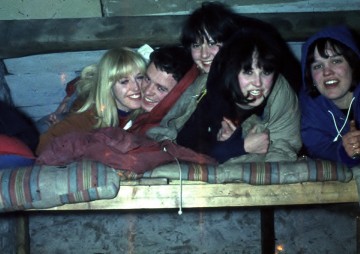
seems to recall that this was to do with the YWCA not liking young women sleeping in the hut with young men. An earlier Minute noted: ASSOCIATE MEMBERSHIP – it was agreed that women would become Associate Members their numbers being limited to ten. By my reckoning, that would have meant that women would outnumber the male membership so the logic was good. As usual, nobody took any notice.
The now closed Grouse was our main watering hole in the early days with hosts Ted and Sylvia making us most welcome. As with many climbing groups we indulged ourselves in darts in the evening with Cioch Killer being most favoured which involved the best players being picked on by the rest to eliminate them. We also had the powerfully built figure of Jack Street’s brother, Jim, who didn’t climb too much but was nevertheless part of our group. Jim had a way with words as he demonstrated outside The Grouse one Saturday night with two unknown youths. Dave Nowill and I deftly side-stepped them as we left but by the time we had crossed the road we looked back to see both youths on the ground unaware that Jim had trained as a boxer.
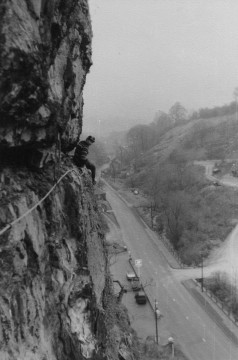
Bad weather sometimes involved indoor games, the most dangerous being Cioch Club Cricket which involved a rucksack for a wicket, a piece of stick for a bat and an empty bean can which was not so much bowled but thrown full toss. Nobody would play wicket keeper and fielders were hidden under sleeping bags on the bunks. It all ended badly on one occasion with blood sprouting profusely from somebody’s finger. It was all good fun until good weather forced us out of the hut. The mood of new-routeing prevailed regardless of quality as highlighted by the 160ft VS traverse of Brassiere Strap by Chris Jackson and Graz; a route where rock was occasionally used between the vegetation. John Gerard climbed a crack on the right wall of Brown Corner then traversed left and up the top pitch of Damocles to create the quite exciting but slightly wandering route The Sword, HVS. Brassiere Strap was not the first rambling expedition at Stoney as the 1962 guide records listed after Little Capucin and, therefore, to the right of that route:
DANDRUFF ½mile Very Difficult
By any start gain a grassy stance high on the right-hand side of the tower, block belays above. Under the overhang traverse right along an obvious weakness leading to exposed vertical scree, which showers down like scurf. Press on diligently to better rock and a small stance and piton belay. Such horizontal rambling may be continued for a great distance, but it is usual to carry on only as far as the first tree capable of supporting an abseil.
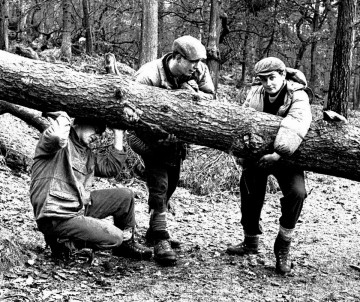
In theory, this should climb up the front face of Shining Cliff to below Little Capucin, then traverse right across the footpath and continue towards The Triglyphs across mixed ground. I don’t know anybody who has repeated this so a second ascent likely awaits of which a report would be welcome. The same guidebook also records The Doldrums which is in fact what we know as the Carl’s Wark area.
1963-65 thereabouts…
At some point, the Parnassus MC rented the hut directly beneath ours. They were like poor neighbours who I can’t recollect having neither electricity nor water nor the luxury bunks that adorned our hut. Their hut had in fact been a blacksmiths and the walls were still adorned in soot. They were nevertheless friends and we cross socialised and even climbed with the likes of Les Willams, Captain Mick and Colin ‘Domehead’ Crookes who himself made his own contribution to new routes with Dome’s Groove in The Quarry which was always overgrown in particular with wild barbed roses which made progress in the upper groove quite difficult.
Another imposing crack in The Quarry, Damocles, was climbed at A2 by Dearman, Street and Jackson which I repeated a while later with one point of aid on the upper overhang, that last point finally being freed some years later by Ron Fawcett about 1976. This was a route with a wide crack in which wooden wedges were used on early ascents.
Brian Moore made steady contributions to the crag apart from Pendulum and Alcasan, the most familiar being Fe-Fi-Fo-Fum and its sister climb Augean along with the messy Juggernaut replied to by the even grottier Truffle by Jackson and Choss by Street. More and more filler-in routes were climbed which suffered from being overgrown and almost all needed some level of gardening. Brian Moore took this grotty exploration to do a new route with Nowill:
Orrid 120ft Hard Severe A fine route of a mountaineering nature
50ft. Ascend the wall below Windy Ledge in line with Windhover – ivy root belay up to the right.
70ft. Traverse across ivy-covered rock to a rose bush. Carefully climb the wall above to gain the groove – Windy Ledge is reached with relief.
Brian’s adventures weren’t all on bad rock as shortly after, he and Pete Fieldsend made the first ascent of The Spider, which takes the widest point of the impressive overhang on Plum Buttress in Chee Dale in three pitches. The second pitch took the overhang and three hand-placed bolts and six pitons to reach a stance on the lip. Then the overhang and wall above was climbed with another bolt and seven pitons; tough stuff.
I can understand the demise of aid climbing and contributed to its decline myself but there is a romantic memory of those times. We certainly were not aware of the extent of aid climbing on such a grand scale in Yosemite which was going on at the same time.
Little Plum
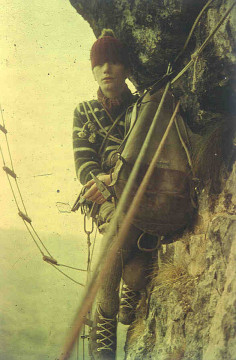
Back in the village, I once again arrived at Stoney on an October Saturday lunchtime where Chris Jackson was waiting for me at the bus stop. He had just started up the lower pitch of what would become Little Plum on Garage Buttress but Nowill, his companion, had mutinied early leaving Hot Pants in need of another sucker, a young and 16-year-old gullible youth.
Up on the crag, Chris set off and placed another peg then passed me the rope to take over. In my naivety, I trusted him, went up and after placing another peg continued up the second half of the pitch, largely free climbing with little protection but as I recall, the odd peg was in place at the break of Pendulum which sufficed as a belay. Free climbing that section was not hard going and there is the problem that once you have started free climbing it is difficult to stop and place a peg. Chris joined me at the break and as I recall we traversed right along Pendulum and down to a ledge and small tree on what became Evasor from where we abseiled off. We went back the following day from the top using a caving ladder and as the second man down was only belayed from below at the rake, he would have been in for a long fall if he had fallen. We did make progress on the top pitch which overhung us but we needed small blade pegs and we only had two so we retreated again up the wooden ladder and during the week went to Jackson and Warr in Sheffield to buy two more. The
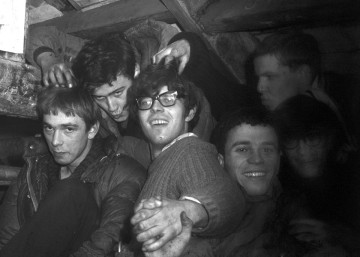
following weekend we returned and over two days managed to place another couple of pegs but again ran out and so it was back to the shop again. However, come the next Saturday, now November 2nd, we attacked once more and this time Chris overcame the overhang to reach easier ground and the top. The most dangerous thing had been down-climbing the ladder as second man without protection.
Medusa
I’ve already written about my experience with Medusa in the Len Millsom section but here is what was written in the hut book by what appears to be the hand of Ackers but he denies it:
During the day, a certain young daring climber went out to the crag and attempted to achieve the impossible by leading a certain little crack by the name of Medusa. On leaving the floor, he was heard to gurgle quietly to himself and, as he moved upwards with surprising agility, someone pointed out the resemblance to one of his remote ancestors. Surmounting the overhang he made a strange layback move which unfortunately resulted in a nasty victory of ‘Father Down’. Pretending to be Hermann Buhl he sprang back at the crack and after only a few hour’s climbing, a meal break and several other nasty frights to the crowd he got to a ledge below the exit cracks. By now a large crowd had gathered and watching with horror they saw the lad move higher and higher. Slowly he edged nearer the top. Getting his feet on the top he was overcome by a fierce attack of gravity and ‘Father Down’ again won the round. After this the crowd cheered and the lad was lowered to the floor.
Later, the lads were unfortunately made to suffer all the usual tales of daring and adventure and we all offered our congratulations on the best fall of 1964.
YOUNG LAD = G Birtles (Glory Seeker) Club Hero 1964
That was 4th January 1964 and a week later Jack led it, probably the third ascent, and, still suffering bruised ribs, I finally led it a week after that.
Local hero
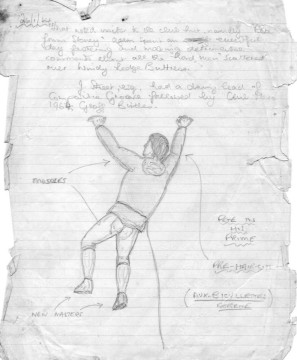
About this time, we were joined by a local lad called Pete Hobson who lived with his parents just up the little lane behind the Stoney chip shop. Pete had no previous interest in climbing but simply became our friend as a local in The Grouse and in due course got his own rock boots and came on the crag with us and even stopped in the hut. His real claim to fame was that whilst leading the traverse on Froth he fell. His second failed to hold the rope but clutching the ivy which unfurled as he fell all the way to the ground unharmed.
A page from one of the Cioch Club hut books depicting Pete Hobson. Artist unknown.
Icarus
Flushed with success, Jack took new-routeing to task and came up with the idea of traversing the Brown Corner bay. Traversing was very much in vogue in those days and I certainly enjoyed them maybe because you spent so much time in exhilarating positions. The drawback was seconding as the leader would make sure there would be good runners to protect the hard moves. Conversely, the second had to remove said runners and then make the hard moves facing long falls. Thus it was that Jack led me along the high break that traversed leftwards into Brown Corner and from there, a step left and the pulling of some slack through allowed a jump into the tree. If you missed the tree, the extra slack would have meant a longer fall. Jack belayed in the tree and I joined him. Then we went to the cafe for a mug of tea after which we went back and with me belaying from the ground, Jack reclimbed the tree and, with just a sling round that, bridged across the wall and set off along the break and up the wall above Jasper with no more protection. The climbing was not hard but it was bold and on-sight. Some years later, I was repeating it with the noted doyen of British climbing in the 60s, Pete Crew, who refused point blank to jump into the tree and climbed a little further left until he could make the bridge. When Dutch Elm Disease ravaged Britain, the tree was taken down and whilst it opened up the wall – it was lamented a little.
The Flakes
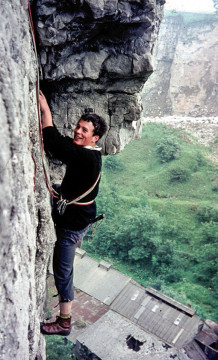
Jackson)
There is a note in the hut book dated 26.1.64 which reads: Chris and Brian did the ‘Flakes’ – 4½ hours. This was essentially a free ascent which he did shortly after with Brian Starkey. I don’t recall him mentioning that he was going to do this and apart from Windhover, Windy Buttress was mentally allocated to the realm of aid climbing and so it was with some amazement that he returned down to the cafe with the news of his ascent. He had used a peg for aid to enable the last move of the traverse into Kingdom Come which should not distract from what was a magnificent foray into the world of free climbing on steep limestone. It would be another year before Chris Bonington and Tony Greenbank made their memorable ascent of Coronation Street up the imposing limestone of Cheddar Gorge. History was being made at Stoney Middleton by none other than Chris ‘Irresistible’ Jackson (That was another of his nicknames which we think he coined bearing in mind that
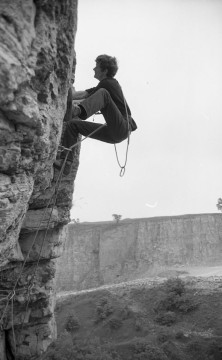
Baby Face Jackson came from him being asked for ID in pubs when he was 21 years old.) Dearman’s original aid ascent had taken what is now known as Flakes Direct which I free climbed initially with a sling for aid but later did without. Those initial layback moves are among the most thrilling at Stoney and not that hard.
Memnon
Some time early in 1964, I teamed up with Brian ‘Wattles’ Starkey and I led the corner below Scoop Wall at road level which ended at the right end of Windy Ledge. From there I set off up the vague crack and weakness at the right-hand end putting in a couple of pegs to a point where the wall bulged. There, I dropped what pegs I had and being committed to standing in a sling, I could have lowered off from there as I had intended to use more aid. Instead I climbed on to the top with nothing else. Memnon is not the greatest route at Stoney but it did climb the whole buttress along with Aurora. Looking back, it is hard to understand why we stood in slings which moved about giving a very insecure feeling and psychologically very hard to leave though invariably when we did get back on the rock proper a sense of security returned.